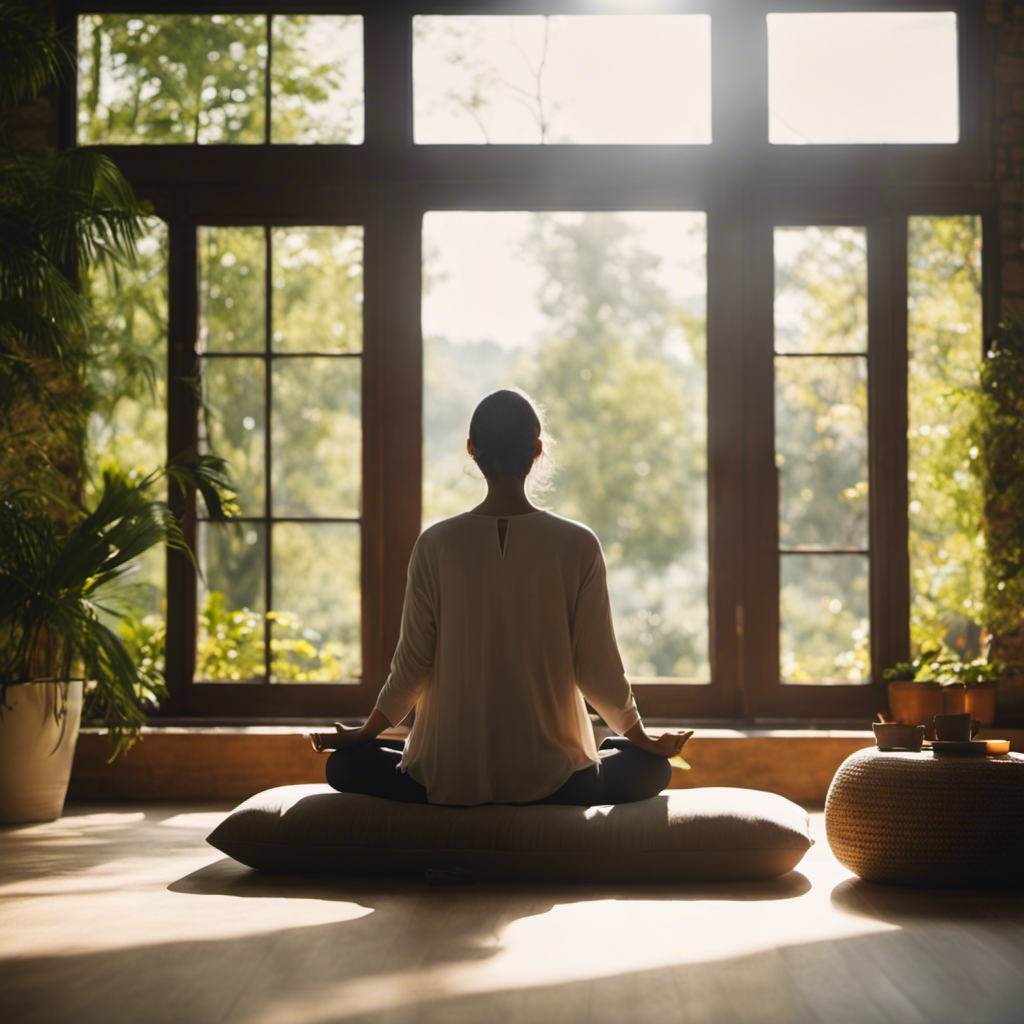Are you ready to embark on a journey of self-discovery and inner peace? Starting to meditate may seem intimidating, but fear not! In this article, we will guide you through the process of beginning your meditation practice. Find a cozy spot, take a deep breath, and allow yourself to relax. With our patient and compassionate guidance, you’ll soon be experiencing the countless benefits that regular meditation can bring to your life. Let’s get started!
Understand the Purpose of Meditation
To understand the purpose of meditation, you’ll need to explore its various benefits and how it can positively impact your mental well-being. Meditation offers a multitude of advantages that can enhance your overall quality of life. One of the primary benefits is gaining a deeper understanding of yourself and your thoughts, which can lead to increased self-awareness and self-acceptance. Additionally, regular meditation practice has been shown to reduce stress levels, anxiety, and depression by promoting relaxation and calming the mind. It can improve concentration and focus, allowing you to be more present in every aspect of your life. By incorporating meditation into your routine, you are taking a proactive step towards nurturing your mental health and creating a sense of inner peace.
Find a Quiet and Comfortable Space
Finding a quiet and comfortable space is essential when starting to meditate. Creating a dedicated meditation space in your home can help you establish a routine and find inner peace. Look for a spot that is free from distractions, such as noise or clutter. It could be a corner in your bedroom, a cozy nook by the window, or even a peaceful garden if you have one. Make sure the area is clean and tidy, allowing you to relax fully. Add elements that promote relaxation, like soft cushions or blankets, scented candles, or calming artwork. This space should reflect your personal style and create an atmosphere of tranquility. Remember that finding inner peace begins with finding external peace within your meditation space.
Choose a Meditation Technique
When choosing a meditation technique, it’s important to explore different styles and find one that resonates with you. There are various meditation techniques available, each offering unique benefits. To help you choose the right technique for your needs, here is a table outlining four popular meditation styles and their benefits:
| Technique | Benefits |
|---|---|
| Mindfulness | Reduces stress, increases focus and attention, cultivates self-awareness |
| Loving-kindness | Cultivates compassion and empathy, promotes positive emotions |
| Transcendental | Promotes deep relaxation, reduces anxiety and depression |
| Guided | Helps beginners by providing instructions or visualizations to guide the meditation |
Remember that different techniques work better for different individuals. Some may prefer the quiet introspection of mindfulness, while others might find guided meditations more helpful in staying focused. It’s essential to experiment with different techniques until you find one that resonates with you and brings about the desired benefits. Don’t be discouraged if one technique doesn’t work for you – keep exploring until you discover what works best for your unique journey towards inner peace and well-being.
Set a Time for Your Meditation Practice
Once you’ve determined the best meditation technique for you, it’s important to establish a consistent time for your practice. One of the most beneficial times to meditate is in the morning. Starting your day with a calm and focused mind can set a positive tone for the rest of the day. By creating a morning meditation routine, you give yourself the opportunity to experience increased clarity, reduced stress, and improved overall well-being. However, distractions during meditation can be common for beginners. To overcome these distractions, try finding a quiet space where you won’t be easily interrupted. You can also use tools like soft background music or guided meditations to help keep your focus. Remember, it’s normal for thoughts to arise during meditation; gently acknowledge them and then bring your attention back to your chosen focal point, whether it’s your breath or a mantra. With patience and practice, you will gradually become more adept at staying present and calm during meditation sessions.
Relax Your Body and Mind
To fully relax your body and mind, it’s important to create a calm and quiet space where you won’t be easily interrupted. Finding this peaceful environment will allow you to focus on the present moment and engage in relaxation techniques that can benefit both your physical and mental well-being. Mindfulness, a practice of being fully present in the moment without judgment, has been shown to reduce stress, improve sleep quality, enhance concentration, and increase overall happiness. By incorporating mindfulness into your daily routine, you can experience these benefits firsthand. Start by taking a few moments each day to sit comfortably, close your eyes, and bring awareness to your breath. Notice the sensation of each inhale and exhale as you let go of tension in your body. As thoughts arise, gently redirect your attention back to the breath. Remember, it takes time and practice to cultivate mindfulness skills, so be patient with yourself along this journey of self-discovery.
Focus on Your Breath or a Point of Focus
Take a moment to bring your attention to your breath or choose a point of focus, allowing yourself to fully engage in the present moment. Breath awareness is an essential aspect of meditation for beginners. Here’s how you can incorporate breath awareness into your practice:
Find a comfortable position: Sit or lie down in a quiet space where you won’t be disturbed.
Close your eyes: This helps to minimize distractions and allows you to turn your focus inward.
Notice your breath: Pay attention to the sensation of each inhale and exhale, without trying to change anything.
Guided visualization: Imagine that with each inhale, you are breathing in calmness and clarity, while releasing tension and stress with each exhale.
Be Kind and Patient with Yourself
Remember, it’s important to be kind and patient with yourself as you cultivate a sense of inner peace and presence during meditation. Starting a meditation practice can be challenging, especially for beginners. It’s natural to feel frustrated or restless when you first begin, but remember to approach yourself with self-compassion and acceptance. Recognize that meditation is a journey, and like any journey, it takes time and practice to find your rhythm. Be gentle with yourself if your mind wanders or if you struggle to stay focused. Instead of judging yourself harshly, simply acknowledge the thoughts that arise and gently bring your attention back to your breath or point of focus. Embrace the process of learning and growing in meditation, knowing that each moment is an opportunity for self-discovery and inner transformation.
Start with Short Meditation Sessions
Start with shorter meditation sessions and gradually increase the length as you become more comfortable and experienced. It’s important to be patient with yourself when starting a meditation practice. Short meditation sessions can still offer numerous benefits, such as reducing stress, improving focus, and promoting inner peace. Begin by setting aside just a few minutes each day to sit quietly and focus on your breath or a chosen mantra. Find a quiet and comfortable space where you won’t be disturbed. As you get used to this routine, gradually increase the duration of your sessions. Remember that consistency is key when it comes to reaping the benefits of meditation. Try incorporating these short meditation breaks into your daily life – during lunch breaks, before bed, or even while waiting for an appointment. Start small, but don’t underestimate the power of taking a few moments for yourself each day.
Establish a Consistent Meditation Routine
Make sure to set aside a specific time each day to meditate, as establishing a consistent routine will help you deepen your practice and experience the full benefits of meditation. Building a meditation habit can be challenging at first, but with patience and perseverance, it is definitely achievable. Start by choosing a time of day that works best for you, whether it’s in the morning before starting your day or in the evening before bed. Find a quiet space where you can be uninterrupted and comfortable.
Overcoming common meditation obstacles is an important part of building a consistent routine. It’s normal to encounter distractions or wandering thoughts during your practice. Instead of getting frustrated, gently bring your attention back to your breath or chosen focal point. Remember that consistency is key, so even if you miss a day or have shorter sessions sometimes, don’t give up. Be kind and compassionate with yourself throughout this journey and celebrate every small step forward. With time and dedication, meditation will become an integral part of your daily life, bringing peace and clarity into each moment.
Enjoy the Benefits of Regular Meditation Practice
Consistency in meditation practice allows you to fully experience the benefits it brings into your daily life. By committing to a regular meditation routine, you open yourself up to a world of mindfulness and inner peace. The benefits of mindfulness are profound and far-reaching. As you cultivate a habit of meditation, you will begin to notice an increased sense of calm and clarity in your mind. Your ability to manage stress improves, allowing you to approach challenges with a greater sense of ease. With regular practice, you may also find that your relationships improve as you become more present and attentive with others. Meditation is not just something you do for a few minutes each day; it becomes a way of being, transforming every aspect of your life for the better. So take some time each day to sit in stillness and explore the many benefits that meditation has to offer. You deserve the peace and tranquility that awaits within.
Frequently Asked Questions
How long should I meditate for as a beginner?
As a beginner, it’s important to start with shorter meditation sessions, gradually increasing the duration. Aim for 5-10 minutes initially and then extend it as you feel comfortable. Remember, the benefits of meditation are immense and there are different techniques you can explore.
Can I meditate in any position or posture?
Different meditation postures can be used, such as sitting cross-legged or on a chair. While there isn’t one “better” posture, finding one that is comfortable and stable for you can enhance your meditation experience. Posture affects your focus and helps create a conducive environment for inner stillness.
Is it necessary to close my eyes while meditating?
It is not necessary to close your eyes while meditating. Meditating with eyes open can help improve focus and awareness. Beginners can try different techniques like focused attention or mindful breathing to start their meditation practice.
How do I deal with distractions during meditation?
To deal with distractions during meditation, gently acknowledge any wandering thoughts and then bring your focus back to your breath or chosen anchor. Remember, it’s natural for the mind to wander, so be patient and kind to yourself as you maintain your focus.
Can I listen to music or use guided meditation apps while meditating?
Yes, you can listen to music or use guided meditation apps during your meditation practice. However, it’s also beneficial to try silent meditation as it allows you to fully immerse yourself in the present moment and cultivate inner stillness.
Conclusion
Congratulations on taking the first step towards a regular meditation practice! Remember, meditation is a journey that requires patience and kindness towards yourself. As you begin this transformative practice, find a quiet and comfortable space where you can relax your body and mind. Choose a technique that resonates with you and set aside a specific time for your daily sessions. Start with short meditation sessions and gradually increase the duration as you become more comfortable. By establishing a consistent routine, you will experience the numerous benefits that regular meditation brings to your life. Enjoy this beautiful journey of self-discovery and inner peace!

